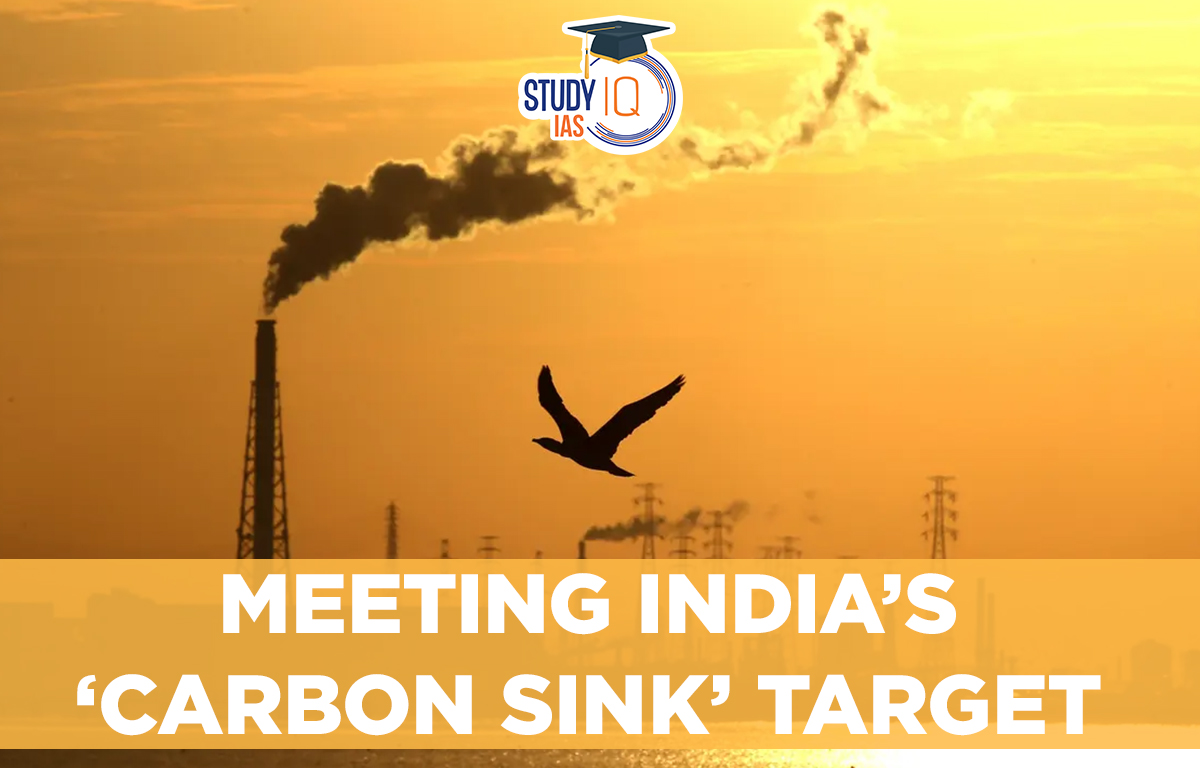Table of Contents
Meeting India’s ‘Carbon Sink’ Target Background
- India’s NDCs under the Paris agreement: India’s key targets for 2030 under its Nationally Determined Contributions (NDCs) to the Paris Agreement include:
- To reduce the emissions intensity of its GDP by 33 to 35 percent below 2005 levels.
- To achieve about 40 percent cumulative electric power installed capacity from non-fossil fuel-based energy resources by 2030.
- To create an additional carbon sink of 2.5 to 3 billion tonnes of CO2 equivalent through additional forest and tree cover by 2030.
- Updated NDCs: In August 2022, India updated its NDCs to UNFCCC, in which India enhanced two of the original targets and the third target for carbon sink was left untouched.
- India has pledged to reduce the emissions intensity of its GDP by 45per cent from 2005 levels instead of the 33 to 35 per cent promised earlier.
- India has also pledged to ensure that renewables formed at least 50 per cent — up from the original 40 per cent — of its total installed electricity generation capacity.
The Paris Agreement
- Adoption: It was adopted by 196 countries at Conference of the Parties COP 21 to the UNFCCC in Paris in December 2015.
- Goal: To limit global warming to well below 2° Celsius, and preferably limit it to 1.5° Celsius, compared to pre-industrial levels.
- Legal status: It is a legally binding international treaty on climate change.
- Implementation: Central element for implementing the Paris Agreement is the nationally determined contributions (NDCs) of each Party.
- NDCs are commitments made by each country to reduce greenhouse gas emissions and adapt to the impacts of climate change.
What is a Carbon Sink?
- A carbon sink is a natural or artificial reservoir that absorbs and stores carbon dioxide (CO2) from the atmosphere.
- Carbon sinks help to reduce the amount of CO2 in the atmosphere and mitigate the negative effects of climate change.
- Types of carbon sinks: There are two types of carbon sinks:
- Natural Carbon Sinks: These are ecosystems that naturally absorb and store carbon from the atmosphere. The most common natural carbon sinks are:
- Forests: Trees absorb CO2 through photosynthesis and store it in their trunks, branches, and roots.
- Oceans: The Ocean absorbs CO2 from the atmosphere, where it dissolves and forms carbonic acid.
- Soil: Carbon can be stored in soil in the form of organic matter, such as dead plant and animal material, which is broken down by microorganisms.
- Artificial Carbon Sinks: These are human-made technologies that capture and store carbon from the atmosphere. The most common artificial carbon sinks are:
- Carbon Capture and Storage (CCS): CCS technology captures CO2 emissions from industrial processes, such as power plants, and stores it underground.
- Direct Air Capture (DAC): DAC technology captures CO2 directly from the air and stores it underground or repurposes it for other uses.
- Natural Carbon Sinks: These are ecosystems that naturally absorb and store carbon from the atmosphere. The most common natural carbon sinks are:
India’s Progress Towards its Carbon Sink Target
- Increasing carbon sink: Government figures in 2022 showed that in the six years since 2015, the carbon sink in the country had increased by 703 million tonnes of CO2 equivalent, or roughly by 120 million tonnes every year.
- This was primarily due to afforestation and tree plantation programs, such as the Green India Mission and the National Afforestation Programme.
- Ambiguity over the baseline year: India did not specify the baseline year when it submitted the carbon sink target in 2015.
- However, last year, the government appeared to remove the ambiguity regarding the baseline year by committing itself to the baseline of 2005.
- Target within reach: The announcement of 2005 as the baseline suddenly brought the carbon sink target within easy reach.
- In a written reply to a Parliament question in 2022, Environment Minister said, “India had already achieved 1.97 billion tonnes of additional carbon sink as compared to the base year of 2005.
- He added that “the remaining target can be achieved by increasing forest and tree cover of the country through implementation of various central and state sponsored schemes”



 Daily Quiz 05 July 2025
Daily Quiz 05 July 2025
 SSC MTS Apply Online for 1075 Posts – ...
SSC MTS Apply Online for 1075 Posts – ...
 Dynamic Pricing: What It Is and Why It's...
Dynamic Pricing: What It Is and Why It's...





















